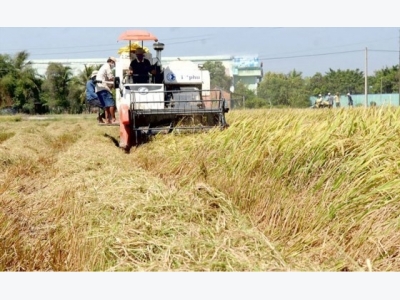Vietnam to decrease rice export volume, increase value

Vietnam would gradually reduce rice export volume and increase quality and value to keep turnover stable in the upcoming time, said the Ministry of Industry and Trade yesterday.
Rice harvest in the Mekong Delta (Photo: SGGP)
The ministry was speaking at a conference on rice export market development strategy according to Decision 942 by the Prime Minister, in HCMC yesterday.
By 2020, Vietnam will export 4.5-5 million tons of rice with the turnover of 2.2-2.3 billion. The export volume will reduce to four million tons by 2030.
According to the ministry, it is needed to change rice export structure to reduce the ratio of long grain white rice of low and medium quality to 20 percent; increase high quality long grain white rice to 25 percent, fragrant and specialty rice to 30 percent, sticky rice to 20 percent. The added value of rice products will approximate 5 percent.
These ratios will be 10 percent, 15 percent, 40 percent, 25 percent and 10 percent by 2030 respectively.
Secretary general of Vietnam Food Association (VFA) Huynh Minh Hue said that rice export has been in the trend of decrease for the last five years. The export volume and turnover dropped from 7.7 million tons and $3.4 billion in 2012 to 4.8 million tons and $2.1 billion in 2016.
By the end of September this year, businesses exported 4.3 million tons of rice, yielding $1.9 billion. The number is forecast to reach 5.6 million tons for the entire year.
Rice structure has changed positively this year. The ratio of high quality long grain white rice is 26 percent, low and quality varieties 13.6 percent, fragrant rice including Japonica rice 30.4 percent and sticky rice 23.4 percent.
Ten major import countries include China, Indonesia, Nigeria, the Philippines, the EU, Saudi Arabia, Iran, Bangladesh, Iraq and Malaysia with the total import demand of 15-17 million tons.
Vietnam is among five major export countries including Thailand, India, Pakistan and the US.
Therefore, VFA says that market orientation and purpose in the upcoming time is to make the most of advantages to develop near and traditional markets and those whose demand suits Vietnamese production conditions such as the Philippines, China and Africa.
In addition, the country will continue repairing problems, get the best of free trade agreements (FTAs) with the EU, Eurasian Economic Union (EEU), Japan and South Korea and expand new market in demand of high quality rice such as Oceania.
Access way change to Chinese market
The Ministry of Industry and Trade said that it is needed to diversify markets, reduce dependence on some markets, exploit opportunities and advantages from FTAs and international commitments.
At present, major rice import markets of Vietnam have been Asia including the Middle East accounting for 71 percent and Africa making up 15.3 percent. The Philippines is traditional market in ASEAN with the demand of about 350,000 tons a year.
Hence, businesses should prepare for market changes and take advantage of competitive advantages from internal transactions within the ASEAN block to keep near markets.
Still, the most important market in short and long term is China. China’s rice consumption demand is very large but the country has not publicized its demand. In addition, it has the policy of protecting local production and strictly controlled import activities through quota granting.
Formerly, Vietnamese rice was mainly exported to China through petty trade but it has mostly been through official channels. China has just permitted 22 Vietnamese businesses to export to the market.
Mr. Do Ha Nam, chairman of Intimex Group, said that in long term export of Vietnamese long grain white rice will meet with difficulties as China has given priority to using Thai and Cambodian rice. In addition, Vietnamese rice has also faced severe competition from Pakistani rice.
Therefore, there need be negotiations in the two countries’ FTA to boost export in the upcoming time.
VFA's secretary general Huynh Minh Hue said that rice export firms should improve competitive ability and connect together to protect their rights.
Related news
 Dầu Tiếng Rubber Corporation invests in high-tech agriculture
Dầu Tiếng Rubber Corporation invests in high-tech agriculture Dầu Tiếng Rubber Corporation plans to build a high-tech agriculture zone, on an area of 2,000 hectares to improve efficiency in land use.
 Viet Nam rice industry should focus on quality: experts
Viet Nam rice industry should focus on quality: experts Vietnamese rice producers and exporters should focus on quality and supplying products that are in demand to sustain the production and export of the grain
 Vietnam rice exporters should focus on Asian markets
Vietnam rice exporters should focus on Asian markets Vietnam should put a special focus on traditional rice importers in Asia to ensure the country’s rice trade stability in the long run